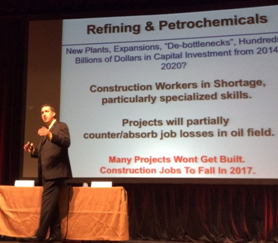Highlights from API’s Tanks, Valves and Piping Conference 2015
At this year’s API Tanks, Valves and Piping Conference and Expo in Las Vegas, Oct. 14-15, more than a dozen presenters shared their expertise in the installation, repair and maintenance of valves, pipes and tanks.
#maintenance-repair
Standards and Practices
In the opening technical sessions, an update was given on API fugitive emissions valve standards and the recommended installation procedures for API622 low emissions packing. To this end, Ron Walters of Teadit stressed the need to know why a valve fails. “It’s important to not just discard it in the interests of time and getting back online. Of course you need to get back online quickly, but it is also essential to actually do a failure analysis. What component caused the failure? If you don’t know that, and why, then you can have the same thing happening again and again. Keep the rings and gaskets, send them to the manufacturer to figure out, if they failed, why? Was it improper installation? Was it the right valve in the first place?”
Walters was followed by Rodney Roth of A.W. Chesterton who pointed out that “a valve is only as good as its weakest link. Think how much travel is going on with the stem. What components are impacted by all that travel? What kind of lubrication are you using and where?”
In another presentation, the 2009 revision to ASME B16.34 regarding valve wall thickness criteria was discussed by David Escobar of Metso Flow Control. “This revision went unnoticed by a lot of people,” he said, “but it has had a big impact on the valve industry.” Added wall thickness criteria means that valves must have more weight, which can have a significant impact on processes like offshore rigs that are very sensitive to weight constrictions. Escobar noted there was no good reason for the change in criteria, and ASME is working to resolve the problem in the next revision of the standard.
Interesting developments in automated waveform analysis for corrosion control monitoring were shared in another session that also included Don Mears of Analytical Training Consultants. Mears presented an impassioned case for “trusting but verifying” everything you are told about the material chemical construction of components in pipes and valves.
The Economy and Oil
This and much more was shared in the first day of the two-day event, which opened with keynote speeches by Houston Federal Reserve business economist Jesse Thompson (pictured, right) and Earl Crochet of Kinder Morgan. According to Thompson, energy is the key to what is happening in the Texas economy. The shale revolution created a boom in 2013, just at the time that the U.S. economy needed help coming out of the “Great Recession.” But this boom was a double-edge sword because the need for construction laborers to build out the infrastructure to service shale drove up wages. Now, as the price of oil has plummeted, it means that the very people who enjoyed those high wages are not interested in taking the lower paid jobs that are available now that shale has tapered off. This could have an effect on the service and affiliated sectors in Texas as the slide in demand for and price of oil continues.
Crochet joked that when people ask him to predict the price of oil over the next year, he is reluctant but can, with some confidence, say that it will range between $20 and $200.
New Technologies
Day Two of the conference was highlighted by some technological developments that could have far-reaching impacts on both production and repairs of valves.
One was presented by Samuel Lomasney of Modumetal who shared the benefits of nanolamination, which layers metals together in myriad combinations to achieve new levels of corrosion resistance. He showed examples of zinc and nickel based nanolamination that demonstrated over weeks and months of testing in various environments that rust and corrosion were virtually non-existent on metals coated with this lamination, even after months in salt spray and high humidity.
Wendy Zhao of TXY-Tech presented another technology that, while more than 20 years old, was not known to many of the attendees. She explained a process of online leak sealing, which she said can save operators from shutdown cost as well as safety issues posed by leaks in a pipeline. Zhao showed examples of the success of a special process of using clamps, sealants and injections tools that stops pinhole leaks or cracks online, while the operations are fully running. These included subsea processes.
There were many more excellent presentations filled with information sure to be of value to readers of VALVE Magazine. Come back regularly to VALVEMagazine.com for articles on topics such as managing piping and valve requirements at a corporate level, the application of standard block valves for throttling, and misconceptions and mistakes in leak testing valves.
Kate Kunkel is senior editor of VALVE Magazine. Reach her at kkunkel@vma.org.
RELATED CONTENT
-
PSV Inspection: Test Only, or Full Inspection and Overhaul?
In today’s ever-changing, fast-paced world, uptime is at a premium, while remaining in compliance with governmental and plant regulations is a requirement.
-
Caution: Horizontal Stem Installation Ahead
When it comes to linear valve installations, gravity is our friend.
-
Keeping Main Steam Isolation Valves in Top Condition
Because of the critical function of main steam isolation valves in nuclear applications, keeping these valves running at optimum performance levels is vital.









 Unloading large gate valve.jpg;maxWidth=214)


